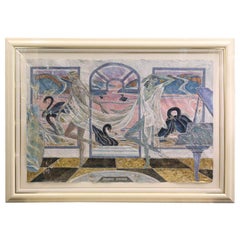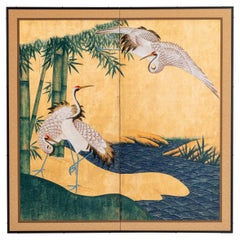Chinese Paintings and Screens
1
to
1
1
1
1
1
1
1
1
1
1
1
1
1
1
7
4
1
1
1
Place of Origin: Chinese
Creator: Yamin Young
"View from the Terrace, " Mixed-Media by Yamin Young
By Yamin Young
Located in Houston, TX
Well listed Chinese Artist Yamin Young. "View from the Terrace". Mixed-media on handmade rice paper, mounted to the fabric base, protected by the plexiglas...
Category
Late 20th Century Other Chinese Paintings and Screens
Materials
Gold Leaf
Related Items
Contemporary Hand-Painted Japanese Screen of Cranes by the River
Located in 10 Chater Road, HK
The cranes by the river painting of this two-panel screen is hand-painted in watercolor, on squares of gold leaf which are applied by hand to the paper base over carefully jointed wo...
Category
2010s Chinese Paintings and Screens
Materials
Gold Leaf
circa 1930 Japanese Silver Screens by Isoi Joshin, Flowers of the Four Seasons
Located in Kyoto, JP
Flowers of the four seasons
Isoi Joshin (1883-1964)
Pair of six-panel Japanese screens
Ink, pigment, lacquer and silver leaf on pa...
Category
Mid-20th Century Showa Chinese Paintings and Screens
Materials
Silver Leaf
H 69 in W 149 in D 0.75 in
Japanese Two Panel Screen Moon Viewing
Located in Hudson, NY
Japanese two panel screen: Moon Viewing, painting of two noblewomen admiring the full moon outdoors. Extremely sophisticated execution of painting ove...
Category
1970s Showa Vintage Chinese Paintings and Screens
Materials
Silk, Wood, Paper
Pair of Japanese Edo Six Panel Screens the Seven Sages
Located in Rio Vista, CA
Fantastic pair of 19th century Japanese late Edo/early Meiji period six-panel screens titled The seven sages of the bamboo grove. The Kano school screens...
Category
19th Century Edo Antique Chinese Paintings and Screens
Materials
Brass, Gold Leaf
Japanese Six Panel Screen, Peonies and Young Growth on Gold Silk
Located in Hudson, NY
Rimpa floral scene. Pigment on gilded silk, signature and seal read: Hattori Shunyo. Bold colors and strong design elements combined with the trademark tarashikomi (diluted elements created when water is applied to the surface before or after pigments causing them to diffuse) exhibit the artists deep devotion to this important Japanese painting tradition. Notes about artist: Hattori Shunyo (b. 1883) was an artist from Kyoto who graduated the (now) Kyoto Municipal University of Art and fell under the circle of Yamamoto Shunkyo...
Category
Early 20th Century Chinese Paintings and Screens
Materials
Brocade, Silk
Japanese Six-Panel Screen Women of the Court in the Garden
Located in Hudson, NY
Japanese six-panel screen: Women of the Court in the Garden. Edo period (circa 1700) painting of an early Kano school subject matter: nobility socializing in a coutryard garden. Deta...
Category
Early 1700s Edo Antique Chinese Paintings and Screens
Materials
Gold Leaf
Japanese Six Panel Screen, Young Pine and Bell Flowers
Located in Hudson, NY
Signature reads: Kanshin. Mineral pigments painted on gold dusted mulberry paper with a silk brocade border.
Category
Late 19th Century Antique Chinese Paintings and Screens
Materials
Gold
Japanese Silk Suijaku Scroll Nyorai-Kojin with Mixed Buddhism and Shinto Deities
Located in Atlanta, GA
A Japanese silk Suijaku hanging scroll beautifully presented in a custom wood shadow box frame from Edo period (circa 18-19th century). The scroll, surmounted on golden brocade was painted in fine details with gouache, ink and gold powder highlight, served as a Suijaku mandala for the worshippers. Honji Suijaku is a complicated religious concept uniquely developed in Japan. It mixed and hybrid the Buddism deities with native shinto spirits (known as Kami), which were seen as local manifestations (the suijaku, literally means a "trace") of Buddhist deities (the honji literally the original ground). The original idea may lie with the synergetic strategy to spread Buddism by making it more relatable to the local population who had already worshiped Shinto gods. The paradigm, adopted in the 10th century from an orignal Chinese concept, remained a defining feature of Japanese religious life up to the end of the Edo period (1868). Instead of being confined to deities, its application was often extended to historical figures as shown on this scroll.
This long hanging scroll depicts an arrangement of 21 figures including Buddhism and Shinto deities as well as two historical figures on the bottom. Each figure was name-tagged in Kanji for easy identification by the worshippers. It was used in the temple or shrine so that when the worshipper prayed in front the mandala, they prayed simultaneously to all the deities.
On the very top, sits Nyorai-Kojin, a hybrid deity of Nyorai Buddha and Kojin, the kaki for fire, stove and kitchen. From the top to bottom and left to right, here is the list of the deities: Kanon with Thousand Hands, Kanon with Willow Branch, Monju Bosatsu...
Category
Early 19th Century Edo Antique Chinese Paintings and Screens
Materials
Silk, Wood
H 85.5 in W 33.5 in D 3 in
Japanese Two Panel Screen Young Pine and Pine Cones on Gold
Located in Hudson, NY
Mineral pigments on gold leaf on mulberry paper with a silk brocade border.
Category
Early 1800s Antique Chinese Paintings and Screens
Materials
Brocade, Silk, Paper
Japanese Six Panel Screen Battle of Yashima from the Heike Monogatari
Located in Hudson, NY
Yamato-e painting depicting a great land and sea battle, the Battle of Yashima, March 22, 1185. The Heike were flushed from the mountainous and prote...
Category
18th Century Antique Chinese Paintings and Screens
Materials
Gold
'Two Dutch Ships Anchored in the Bay of Nagasaki' by Kawahara Keiga '1786-1860'
Located in Amsterdam, NL
Kawahara Keiga (1786 - c. 1860)
Two Dutch ships anchored in the bay of Nagasaki
Sumi ink and pigment on silk, H. 27 x W. 41 cm (excl. frame)
Comes framed, see image.
?Based o...
Category
Early 19th Century Antique Chinese Paintings and Screens
Materials
Silk
Free Shipping
H 10.63 in W 16.15 in D 1.19 in
Japanese Two Panel Screen Dragon in the Mist
Located in Hudson, NY
Ink (Sumi) on paper. Signature and Seal read: Kishi Ganku It is backed with paper covered in gold and silver flake. Kishi Ganku (1749 or 1756-1839) was the...
Category
Early 19th Century Edo Antique Chinese Paintings and Screens
Materials
Wood, Paper
Recently Viewed
View AllMore Ways To Browse
Japanese Folding Screens
Folding Screen Japanese
Japanes Folding Screens
Asian Gold Leaf Panel Art
Japanese Screen Lacquer
Mid Century Chinese Screen
Japanese Panel Gold Wood
Lacquer Seal
Silk Asian Set
Chinese Bird Painting
Japanese Art Of Cranes
Japanese Hand Painted Bird Art
Pair Of Japanese Panels
Small Wood Screen
Bird In A Bamboo
Japanese Lacquered Screen
Antique Japanese Painting On Silk
Black Lacquer Gold Panels


